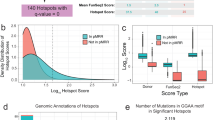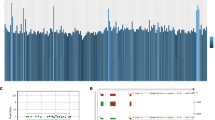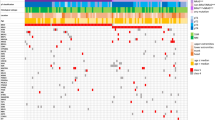Abstract
Approximately 8-12% of melanoma is inherited in an autosomal dominant fashion with variable penetrance1,2,3,4,5,6,7,8. A chromosome 9p21 locus has been linked to this disease in 50-80% of affected families5,6,7,9. CDKN2A (also known as P16, INK4, p16INK4A and MTS1) is allelic to this locus and encodes a cdk4/cdk6 kinase inhibitor that constrains cells from progressing through the G1 restriction point10,11,12. Although germline CDKN2A coding mutations cosegregate with melanoma in 25-60% of families predisposed to the disease8,9,13,14,15,16,17,18,19, there remains a number of mutation-negative families that demonstrate linkage of inherited melanoma to 9p21 markers9. We show here that a subset of these kindreds possess a G→T transversion at base –34 of CDKN2A, designated G–34T. This mutation gives rise to a novel AUG translation initiation codon that decreases translation from the wild-type AUG. The G–34T mutation is not seen in controls, segregates with melanoma in families and, on the basis of haplotyping studies, probably arose from a common founder in the United Kingdom. Characterization of this and other CDKN2A non-coding mutations should have an impact on current efforts to identify susceptible melanoma-prone families and individuals.
This is a preview of subscription content, access via your institution
Access options
Subscribe to this journal
Receive 12 print issues and online access
$209.00 per year
only $17.42 per issue
Buy this article
- Purchase on Springer Link
- Instant access to full article PDF
Prices may be subject to local taxes which are calculated during checkout






Similar content being viewed by others
References
Bergman, W., Gruis, N.A., Sandkuijl, L.A. & Frants, R.R. Genetics of seven Dutch familial atypical multiple mole-melanoma syndrome families: a review of linkage results including chromosomes 1 and 9. J. Invest. Dermatol. 103, 122S–125S (1994).
Goldstein, A.M. et al. Linkage of cutaneous malignant melanoma/dysplastic nevi to chromosome 9p, and evidence for genetic heterogeneity. Am. J. Hum. Genet. 54, 489–496 (1994).
Bale, S.J., Chakravarti, A. & Greene, M.H. Cutaneous malignant melanoma and familial dysplastic nevi: evidence for autosomal dominance and pleiotropy. Am. J. Hum. Genet. 38, 188–196 ( 1986).
Cannon-Albright, L.A. et al. Assignment of a locus for familial melanoma, MLM, to chromosome 9p13-p22. Science 258, 1148– 1152 (1992).
Cannon-Albright, L.A. et al. Penetrance and expressivity of the chromosome 9p melanoma susceptibility locus (MLM). Cancer Res. 54, 6041–6044 (1994).
Goldstein, A.M., Fraser, M.C., Clark, W.H. Jr & Tucker, M.A. Age at diagnosis and transmission of invasive melanoma in 23 families with cutaneous malignant melanoma/dysplastic nevi. J. Natl Cancer. Inst. 86, 1385–1390 ( 1994).
Goldstein, A.M. & Tucker, M.A. Genetic epidemiology of familial melanoma. Dermatol. Clin. 13, 605–612 (1995).
Hogg, D. et al. Role of the cyclin-dependent kinase inhibitor CDKN2A in familial melanoma. J. Cutan. Med. Surg. 2, 172– 179 (1998).
Hayward, N.K. The current situation with regard to human melanoma and genetic inferences. Curr. Opin. Oncol. 8, 136– 142 (1996).
Kamb, A. Cell-cycle regulators and cancer. Trends Genet. 11, 136–140 (1995).
Sherr, C.J. & Roberts, J.M. Inhibitors of mammalian G1 cyclin-dependent kinases. Genes Dev. 9, 1149– 1163 (1995).
Sherr, C.J. Cancer cell cycles. Science 274, 1672– 1677 (1996).
Hussussian, C.J. et al. Germline p16 mutations in familial melanoma. Nature Genet. 8, 15–21 ( 1994).
Kamb, A. et al. Analysis of the p16 gene (CDKN2) as a candidate for the chromosome 9p melanoma susceptibility locus. Nature Genet. 8, 23–26 (1994).
Gruis, N.A., Sandkuijl, L.A., van der Velden, P.A., Bergman, W. & Frants, R.R. CDKN2 explains part of the clinical phenotype in Dutch familial atypical multiple-mole melanoma (FAMMM) syndrome families. Melanoma Res. 5, 169– 177 (1995).
Holland, E.A. et al. Analysis of the p16 gene, CDKN2, in 17 Australian melanoma kindreds. Oncogene 11, 2289– 2294 (1995).
Walker, G.J. et al. Mutations of the CDKN2/p16INK4 gene in Australian melanoma kindreds. Hum. Mol. Genet. 4, 1845– 1852 (1995).
Liu, L. et al. Germline p16INK4A mutation and protein dysfunction in a family with inherited melanoma. Oncogene 11, 405 –412 (1995).
FitzGerald, M.G. et al. Prevalence of germ-line mutations in p16, p19ARF, and CDK4 in familial melanoma: analysis of a clinic-based population. Proc. Natl Acad. Sci. USA 93, 8541– 8545 (1996).
Monzon, J. et al. CDKN2A mutations in multiple primary melanomas. N. Engl. J. Med. 338, 879–887 (1998).
Bergenhem, N.C., Venta, P.J., Hopkins, P.J., Kim, H.J. & Tashian, R.E. Mutation creates an open reading frame within the 5´ untranslated region of macaque erythrocyte carbonic anhydrase (CA) I mRNA that suppresses CA I expression and supports the scanning model for translation. Proc. Natl Acad. Sci. USA 89 , 8798–8802 (1992).
Krude, H. et al. Severe early-onset obesity, adrenal insufficiency and red hair pigmentation caused by POMC mutations in humans. Nature Genet. 19, 155–157 ( 1998).
Pollock, P.M. et al. Haplotype analysis of two recurrent CDKN2A mutations in 10 melanoma families: evidence for common founders and independent mutations. Hum. Mutat. 11, 424–431 (1998).
MacGeoch, C. et al. Genetic heterogeneity in familial malignant melanoma. Hum. Mol. Genet. 3, 2195–2200 (1994).
Borg, A. et al. Novel germline p16 mutation in familial malignant melanoma in southern Sweden. Cancer Res. 56, 2497– 2500 (1996).
Acknowledgements
We thank D. Sidransky and P. Cairns for advice and aliquots of 9p21 markers; J. Kennedy for samples of normal DNA; L. From and M. McKenzie for identification of melanoma-prone families; D. Bailey for assistance with analysis of the liver biopsy specimen; and M. Shennan for assistance in contacting family members. We also thank the patients and their family members who participated in this study. This work was supported by a Terry Fox grant from the National Cancer Institute of Canada (NCIC) to D.H. D.D. is a recipient of a postgraduate scholarship from the Natural Sciences and Engineering Research Council of Canada (NSERC).
Author information
Authors and Affiliations
Corresponding author
Rights and permissions
About this article
Cite this article
Liu, L., Dilworth, D., Gao, L. et al. Mutation of the CDKN2A 5' UTR creates an aberrant initiation codon and predisposes to melanoma. Nat Genet 21, 128–132 (1999). https://doi.org/10.1038/5082
Received:
Accepted:
Issue Date:
DOI: https://doi.org/10.1038/5082
This article is cited by
-
Upstream open reading frames regulate translation of cancer-associated transcripts and encode HLA-presented immunogenic tumor antigens
Cellular and Molecular Life Sciences (2022)
-
Determinants of genome-wide distribution and evolution of uORFs in eukaryotes
Nature Communications (2021)
-
Pathogenic germline variants are associated with poor survival in stage III/IV melanoma patients
Scientific Reports (2020)
-
Characterising the loss-of-function impact of 5’ untranslated region variants in 15,708 individuals
Nature Communications (2020)
-
Loss-of-function uORF mutations in human malignancies
Scientific Reports (2018)



